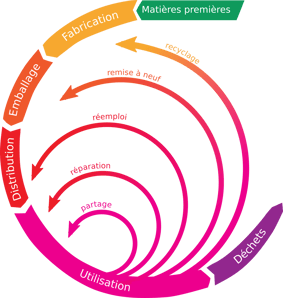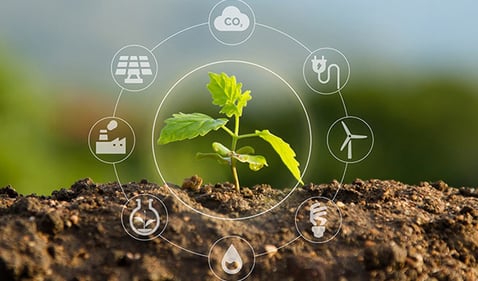What is the circular economy?
31/07/2023
0 comments

Defining the circular economy
Throughout history, the current global economy has been characterized primarily by a "linear" approach that generally takes place in three stages: purchase, consumption and disposal. This system has had the effect of tapping into natural resources, generating an increase in waste and, more generally, destroying the environment.

The circular economy presents itself as a solution to this problem by adopting an economic system based on sobriety, reduction of consumption and recovery of materials or services. This business model works in a loop and aims to eliminate or minimize the use of raw materials by promoting the sharing, repair, reuse or recycling of goods and services circulating in the economy.
The history of the circular economy
The history of the circular economy goes back decades. Although the concept has become increasingly important in our consumer society, it is not so recent. The foundations of the circular economy were laid in the 1960s by visionaries such as Kenneth Boulding, who developed ideas about the economy as a closed system where the waste from one process becomes the resources of another.
Later, in the 1990s, the concept of "cradle to cradle" was formulated by Michael Braungart and William McDonough, focusing on designing environmentally friendly and recyclable products. The term "circular economy" itself was first used in 1989. Over time, the circular economy has grown in prominence and importance, notably due to rising commodity prices, economic crises, environmental awareness and the general deterioration of the environment.
In the corporate sector, many organizations incorporate circular economy principles into their strategies and operations. They seek to optimize the use of resources, develop sustainable products and set up business models based on repair, reuse and rental of products. More and more companies are also committing to circular waste management practices, treating them as resources rather than waste.
The benefits of the circular economy
The circular economy has many economic and environmental benefits. By promoting the reuse and recycling of resources, it makes it possible to :
- Reduce dependence on raw materials, often expensive and exhaustible.
In fact, the European Commission has identified 30 'critical raw materials', both economically key and posing a high risk of supply shortages.
-
Create new green job opportunities and encourage technological innovation in the field of sustainability. In particular, the platform Jobs that make sense allows citizens in search of meaning to meet committed actors in order to reorient together the labour market and put it at the service of the ecological and social transition.
-
Help reduce greenhouse gas emissions and mitigate the effects of climate change. This is the case of Netzero, whose main feature is its innovative biochar production technology. The startup has developed an advanced pyrolysis process, which makes it possible to transform biomass into biochar in an efficient and environmentally friendly way.

The 4 pillars of the circular economy
The circular economy is based on four essential pillars: sharing, repair, reuse and recycling. These are key principles for creating a sustainable and environmentally responsible system.
-
Sharing encourages the collaborative use of goods and services, thereby reducing the need to own one.
-
Repair is intended to extend the life of products by repairing rather than replacing them.
-
Reuse gives products a second life by transforming or using them in other contexts.
-
Recycling recovers materials and components from end-of-life products and reintegrates them into the production of new resources.
The advantage of reconditioning
Reconditioned products play an essential role in the circular economy.
They refer to products that have been previously used, tested and possibly repaired before being put back on the market for a second life.
-
Waste reduction : By giving new life to existing products, repackaged products extend their useful life, thus preventing them from becoming waste prematurely. This helps reduce the amount of waste sent to landfills and incinerators.
-
Conservation of resources : Repackaged products reduce the demand for new resources needed to produce new goods. By repairing and putting them back into circulation, we limit the extraction of raw materials, energy and water needed to manufacture new products.
-
Job and Skills Creation : The repackaging industry creates jobs in the repair and product redesign sector. It requires technical skills to diagnose, repair and test devices, which promotes the development of specialized skills and contributes to local employment.
-
Product Accessibility : Repackaged products offer an affordable alternative to consumers. They are often available at a lower price than new products, allowing more people to access quality goods.
-
Reducing the environmental footprint: By extending the life of products, repackaged products help reduce the environmental footprint associated with their production, transportation and disposal. This helps preserve natural resources and limit greenhouse gas emissions.
Dipli’s place in this economy
Technological devices such as smartphones, computers, etc. are mostly composed and manufactured with rare and exhaustible raw materials. In 2022, 5 billion phones were discarded, with less than 20% recycled according to WEEE. By 2030, these products will represent 74 million tonnes per year.
To address this significant pollution, Dipli is committed to helping preserve the environment by being the first platform to simplify the supply chain for end-to-end used products. Our main objective is to reduce the environmental impact of tech products and to build the market for tomorrow’s reconditioned products.
Dipli aligns perfectly with the main objectives of the circular economy. By helping these devices find a second life, we drastically reduce the environmental impact, including the production that accounts for most of the pollution they generate. Thus, Dipli contributes to the construction of the circular economy with a common goal of safeguarding our planet.







Comments (0)